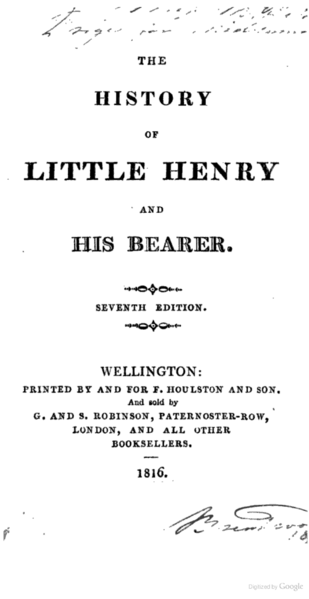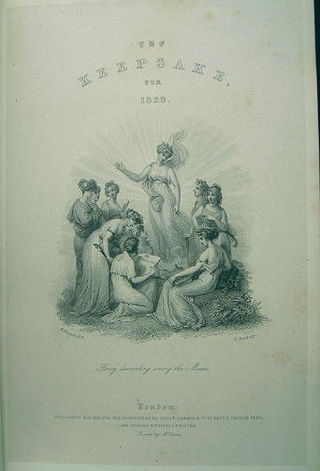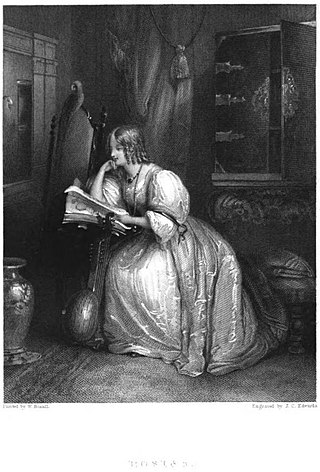
Gothic fiction, sometimes called Gothic horror in the 20th century, is a loose literary aesthetic of fear and haunting. The name is a reference to Gothic architecture of the European Middle Ages, which was characteristic of the settings of early Gothic novels.

Melmoth the Wanderer is an 1820 Gothic novel by Irish playwright, novelist and clergyman Charles Maturin. The novel's titular character is a scholar who sold his soul to the devil in exchange for 150 extra years of life, and searches the world for someone who will take over the pact for him, in a manner reminiscent of the Wandering Jew.

Victor Frankenstein is a fictional character and the main protagonist and title character in Mary Shelley's 1818 novel, Frankenstein; or, The Modern Prometheus. He is an Italian-Swiss scientist who, after studying chemical processes and the decay of living things, gains an insight into the creation of life and gives life to his own creature. Victor later regrets meddling with nature through his creation, as he inadvertently endangers his own life and the lives of his family and friends when the creature seeks revenge against him. He is first introduced in the novel when he is seeking to catch the monster near the North Pole and is saved from near death by Robert Walton and his crew.
Gerald "Jerry" Neal Williamson was an American horror writer and editor known under the name J. N. Williamson. Born in Indianapolis, Indiana he graduated from Shortridge High School. He studied journalism at Butler University. He published his first novel in 1979 and went on to publish more than 40 novels and 150 short stories. In 2003 he received a lifetime achievement award from the Horror Writers of America. He edited the critically acclaimed How to Write Tales of Horror, Fantasy & Science Fiction (1987) which covered the themes of such writing and cited the writings of such writers as Robert Bloch, Lee Prosser, Richard Matheson, Ray Bradbury, H. P. Lovecraft, August Derleth, William F. Nolan, and Stephen King. Many important writers in the genre contributed to the book. Williamson edited the popular anthology series, Masques. Some of his novels include The Ritual (1979), Playmates (1982), Noonspell (1991), The Haunt (1999), among others.

Zastrozzi: A Romance is a Gothic novel by Percy Bysshe Shelley first published in 1810 in London by George Wilkie and John Robinson anonymously, with only the initials of the author's name, as "by P.B.S.". The first of Shelley's two early Gothic novellas, the other being St. Irvyne, outlines his atheistic worldview through the villain Zastrozzi and touches upon his earliest thoughts on irresponsible self-indulgence and violent revenge. An 1810 reviewer wrote that the main character "Zastrozzi is one of the most savage and improbable demons that ever issued from a diseased brain".

The following is a list of the published works of Mary Martha Sherwood. Because it relies on M. Nancy Cutt's annotated bibliography of Sherwood's books in Mrs. Sherwood and her Books for Children, this list does not include her many periodical articles, such as those she wrote for The Youth's Magazine. The list follows Cutt's generic divisions.
Orest Mikhailovich Somov was a Russian romantic writer of Ukrainian origin.

This is a bibliography of works by Mary Shelley, the British novelist, short story writer, dramatist, essayist, biographer, and travel writer, best known for her Gothic novel Frankenstein: or, The Modern Prometheus (1818). She also edited and promoted the works of her husband, the Romantic poet and philosopher Percy Bysshe Shelley. Until the 1970s, Mary Shelley was known mainly for her efforts to publish Percy Shelley's works and for Frankenstein. Recent scholarship has yielded a more comprehensive view of Mary Shelley’s achievements, however. Scholars have shown increasing interest in her literary output, particularly in her novels, which include the historical novels Valperga (1823) and Perkin Warbeck (1830), the apocalyptic novel The Last Man (1826), and her final two novels, Lodore (1835) and Falkner (1837). Studies of her lesser-known works such as the travel book Rambles in Germany and Italy (1844) and the biographical articles for Dionysius Lardner's Cabinet Cyclopaedia (1829–46) support the growing view that Mary Shelley remained a political radical throughout her life. Mary Shelley's works often argue that cooperation and sympathy, particularly as practised by women in the family, were the ways to reform civil society. This view was a direct challenge to the individualistic Romantic ethos promoted by Percy Shelley and Enlightenment political theories.
Bagdemagus (pronounced /ˈbægdɛˌmægəs/), also known as Bademagu(s/z), Bagdemagu, Bagomedés, Baldemagu(s), Bandemagu(s), Bangdemagew, Baudemagu(s), and other variants, is a character in the Arthurian legend, usually depicted as king of the land of Gorre and a Knight of the Round Table. He originally figures in literature the father of the knight Maleagant, who abducts King Arthur's wife Queen Guinevere in several versions of a popular episode. Bagdemagus first appears in French sources, but the character may have developed out of the earlier Welsh traditions of Guinevere's abduction, an evolution suggested by the distinctively otherworldly portrayal of his realm. He is portrayed as a kinsman and ally of Arthur and a wise and virtuous king, despite the actions of his son. In later versions, his connection to Maleagant disappears altogether.

St. Irvyne; or, The Rosicrucian: A Romance is a Gothic horror novel written by Percy Bysshe Shelley in 1810 and published by John Joseph Stockdale in December of that year, dated 1811, in London anonymously as "by a Gentleman of the University of Oxford" while the author was an undergraduate. The main character is Wolfstein, a solitary wanderer, who encounters Ginotti, an alchemist of the Rosicrucian or Rose Cross Order who seeks to impart the secret of immortality. The book was reprinted in 1822 by Stockdale and in 1840 in The Romancist and the Novelist's Library: The Best Works of the Best Authors, Vol. III, edited by William Hazlitt. The novella was a follow-up to Shelley's first prose work, Zastrozzi, published earlier in 1810. St. Irvyne was republished in 1986 by Oxford University Press as part of the World's Classics series along with Zastrozzi and in 2002 by Broadview Press.

The Keepsake was an English literary annual which ran from 1828 to 1857, published each Christmas from 1827 to 1856, for perusal during the year of the title. Like other literary annuals, The Keepsake was an anthology of short fiction, poetry, essays, and engraved illustrations. It was a gift book designed to appeal to young women, and was distinctive for its binding of scarlet dress silk and the quality of its illustrations. Although the literature in The Keepsake and other annuals is often regarded as second-rate, many of the contributors to The Keepsake are canonical authors of the Romantic period.

Charles Theodosius Heath was a British engraver, currency and stamp printer, book publisher and illustrator.

"The Mortal Immortal" is a short story from 1833 written by Mary Shelley. It tells the story of a man named Winzy, who drinks an elixir which makes him immortal. At first, immortality appears to promise him eternal tranquility. However, it soon becomes apparent that he is cursed to endure eternal psychological torture, as everything he loves dies around him.

Monster literature is a genre of literature that combines good and evil and intends to evoke a sensation of horror and terror in its readers by presenting the evil side in the form of a monster.

Mary Wollstonecraft Shelley was an English novelist who wrote the Gothic novel Frankenstein; or, The Modern Prometheus (1818), which is considered an early example of science fiction and one of her best-known works. She also edited and promoted the works of her husband, the Romantic poet and philosopher Percy Bysshe Shelley. Her father was the political philosopher William Godwin and her mother was the philosopher and women's rights advocate Mary Wollstonecraft.

The Bride of Frankenstein is a fictional character first introduced in Mary Shelley's 1818 novel Frankenstein; or, The Modern Prometheus and later in the 1935 film Bride of Frankenstein. In the film, the Bride is played by Elsa Lanchester. The character's design in the film features a conical hairdo with white lightning-trace streaks on each side, which has become an iconic symbol of both the character and the film.

Transformation is a short story written by Mary Shelley and first published in 1831 for The Keepsake. Guido, the narrator, tells the story of his encounter with a strange, misshapen creature when he was a young man living in Genoa, Italy, around the turn of the fifteenth century. He makes a deal with the creature to exchange bodies, but the creature does not reappear at the appointed time to take his own body back. Guido discovers that the creature is pretending to be him, kills it and therefore 'himself', and eventually awakens in his own body.

"The Dream" is a Gothic tale written by Mary Shelley and first published in The Keepsake for 1832. Set in France around the turn of the seventeenth century, it is the story of a young woman named Constance who is in love with Gaspar, the son of her father's enemy. Because their fathers killed each other in battle, Constance feels she cannot marry Gaspar, even though he loves her too. She spends a night on St. Catherine's Couch, a ledge of rock overlooking a river, in the hope that St. Catherine will offer her guidance in her dreams. She does, and Constance and Gaspar are married the next day.

The Invisible Girl is a Gothic tale written by Mary Shelley and first published in The Keepsake for 1833. The tale is set in Wales, and tells the story of a young woman named Rosina, who lives with her guardian, Sir Peter Vernon, and is secretly engaged to his son, Henry. Henry is away from home when their relationship is discovered, and Sir Peter casts Rosina out of the house. Sir Peter regrets his harshness and searches for her, but assumes she is dead when she cannot be found. Henry returns home to the news of Rosina's death and is heartbroken. He joins the search for her body, and the villagers tell him about the Invisible Girl, a ghostly figure who wanders the woods at night. Henry finds Rosina hiding in a remote ruin and discovers that she is really the Invisible Girl. Sir Peter forgives them for their secret engagement, and they are married.

Ferdinando Eboli is a Gothic tale written by Mary Shelley and published in The Keepsake for 1829. It is set in Italy during the Napoleonic Wars and tells the story of an Italian man named Count Ferdinando Eboli whose identity is stolen by his illegitimate older brother.














